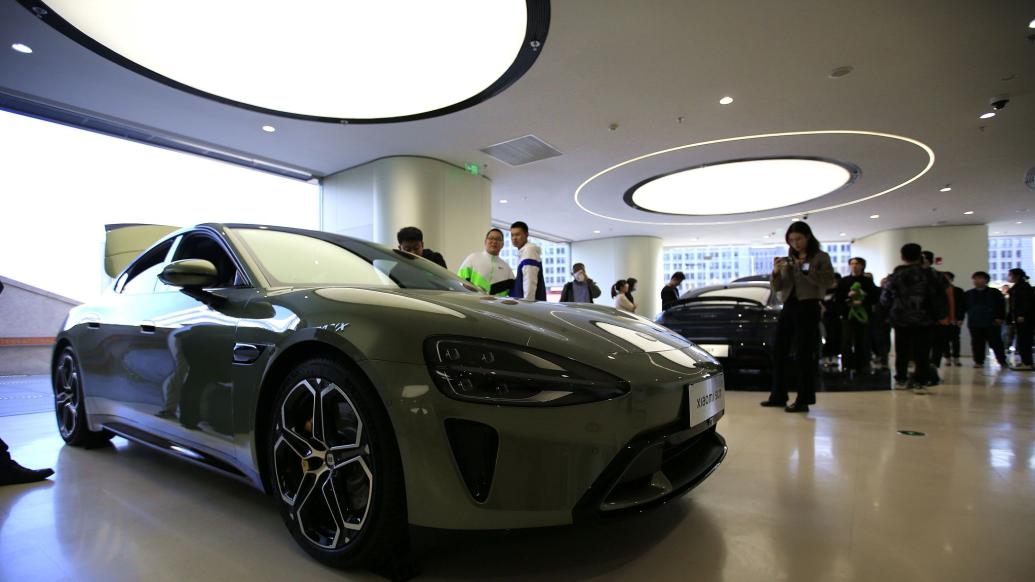Knowing it is unhealthy but unable to stop it, when will the crude car price war end?
- 27 August, 2024
On the eve of the opening of the 2024 Beijing Auto Show, the already fierce price war in the auto market has escalated again.
Tesla, whose prices have never been influenced by the market, has cut prices across its entire series.
Li Xiang, who never gives in, also bowed his head for the first time. Ideal Auto, which said it would not engage in a price war, also reduced prices across the board.
On April 21, Tesla China announced a price cut of 14,000 yuan for all models, including the Model 3 rear-wheel drive version, which originally started at 245,900 yuan and was adjusted to 231,900 yuan. The Model 3 long-range all-wheel drive version was 285,900 yuan and was adjusted to 271,900 yuan.
After the adjustment, the price of the new version of Model 3 is only 16,000 yuan higher than the standard version of Xiaomi SU7.
On April 22, Ideal Auto announced price cuts for its entire product line.
The Ideal MEGA, which has been controversial since its launch, has seen the largest price drop, with a reduction of 30,000 yuan to 529,800 yuan. In addition, the L series models, including L7, L8, and L9, have seen price cuts ranging from 18,000 to 20,000 yuan depending on different configurations.
In 2024, starting with BYD, to the listing of Xiaomi Motors, and then to Tesla and Ideal cutting prices across their entire lineups, the wave of price wars has become more fierce than the last.
Compared with the fuel vehicles of the past, today's popular new energy vehicles are more deeply involved in price wars in order to seize market share.
Back on March 28, the launch of Xiaomi SU7 was like the "Spring Festival Gala" of the car industry this year. No car launch has ever been able to break through the circle and become a social news. One day after the launch, SU7 received 90,000 orders, and the delivery time of the new car was extended from several weeks to several months or even half a year. There was also news on the Internet that users waiting for test drives in Xiaomi stores lined up until 3 a.m.

March 29, 2024, Xiaomi Home flagship store, Oriental Plaza, Beijing.
Xiaomi's overturned table has not even landed yet, but its peers are already like frightened birds. Just two days after the SU7 launch conference, many car companies simultaneously announced price reduction information as if they had discussed it in advance.
First, the top traffic companies officially announced price cuts. For example, Wenjie announced a direct reduction of 20,000 yuan for the entry-level version of the new M7, and NIO offered a maximum subsidy of 1 billion yuan for oil-powered vehicle replacement.
More car companies followed suit. Wuling Motors officially announced that its Wuling Bingo will offer discounts of up to 10,000 yuan, with a post-subsidy price range of 55,800-83,800 yuan.
Zeekr Auto officially announced that its Zeekr 007 has launched a rear-wheel drive enhanced version with an official guide price of 209,900 yuan, which is equivalent to a disguised price reduction of 20,000 yuan.
Geely Auto has offered discounts ranging from 14,000 to 53,000 yuan for its Emgrand L, Xingyue L, and Haoyue series.
In addition, Chery, Jiyue, and even the joint venture brand FAW-Volkswagen have also started to reduce prices, with the Volkswagen Lavida priced as low as 79,900 yuan.
This is exactly the same as the price cuts led by BYD in February. But it is worth thinking about that BYD's strong position is recognized by the industry, and it seems to be a reasonable choice to follow its lead. But Xiaomi Automobile has not been verified by the market, so why did it also cause various giants to hastily cut prices? Has the configuration of Xiaomi SU7 reached such a hysterical level?
In the opinion of Zhang Junyi, managing partner of Oliver Wyman, automakers chose to cut prices simultaneously in the past few days, partly because they wanted to seize the minds of these users before the "7-day no-reason cancellation period" of Xiaomi SU7. Once the 7-day deadline has passed, the order for Xiaomi cars will be locked.
Of course, from a larger perspective, the purpose is to use price changes to boost sales and lay a good foundation for market performance in the second quarter.
Whether price wars are useful or not is difficult to determine using the control variable method. According to recent industry reports, price cuts do not have much impact on users' car purchase decisions, and may even have a negative effect. In addition, users of higher-priced models are less sensitive to price fluctuations.
Zhang Junyi believes that the reason for this situation is that users have their own expectations of the positioning of a certain brand. Within expectations, higher or lower prices will not affect the purchase decision. For ordinary consumer goods, it is normal to increase sales by reducing prices. If it is a luxury product, then price reduction may reduce sales, while price increase will increase sales. Analogously to cars, this can also explain why price wars will benefit the entry-level market but have little effect on the high-end market. Moreover, people who buy luxury cars not only consider the model product, but also care about the subsequent brand experience, service and other implicit benefits.
On the other hand, new car owners will feel that they are getting a good deal after the price cut, but old car owners will definitely feel that they have been stabbed in the back. Therefore, the price war is a "double-edged sword".
For car companies, the impact of price wars is also difficult to estimate. The only thing that is certain is that profits will be hurt. Leading companies have profit margins that can be squeezed, but followers are not so lucky. In the end, they may lose profits and fail to occupy the market. The management of a mainstream new power company told the reporter of The Paper: "Although the market pie is getting smaller, it still exists. The healthy approach is to win customers by improving product and service capabilities. But the most effective short-term means is to cut prices. We know it is unhealthy, but we are powerless to stop it."
In addition, there are also players in the industry who have other interests at heart. The above-mentioned new force person said: "Compared with profit losses, some companies care more about stock market value, so they will take some more extreme measures to digest inventory, which will also affect other brands in the market to follow up."
In his opinion, although lower car prices are good for consumers in the short term, they may not benefit in the long run - "Any drastic measures will backfire," he said.
So in addition to price wars, how else can car companies compete? Zhang Junyi told the reporter of The Paper that according to Michael Porter's competition strategy, competition among automobile companies can be roughly divided into three types: cost competition, market segment competition and differentiated competition. Differentiated competition can be summarized as "I have what others don't, and I am better than others", such as the smart driving that some new forces focus on, such as ultra-long comprehensive range. In this regard, it is already difficult for any company to crush its competitors.
NIO's construction of a power replenishment system can be understood as a form of differentiated competition, but the cost is continuous and large-scale investment. Without the endorsement or even participation of more national institutions, it may be a big challenge for a single enterprise to rely on itself, so NIO has recently introduced many partners, especially the government, because the battery swap system itself has the special attributes of "many hands make light work" and national infrastructure.
Then there is the competition in the market segments, which can be understood as competition in category innovation. The extended-range route that Ideal Auto initially adopted is one of the successful cases of category competition. But now, it has also touched the edge of category homogeneity.
Then there is cost competition, which is the "least technically demanding" (actually the most difficult system competition result) and the most brutal way of competition. To put it more obscurely, it is a competition of system power, but in fact it is a competition for the right to speak among suppliers. And the so-called strong voice means the ability to force suppliers to lower prices. Take the world's No. 1 Tier 1 Bosch as an example. Its senior management revealed in an interview with the media that some OEMs asked it to reduce its supply price by 30% this year. "Then we might as well go bankrupt directly," the senior management said frankly.
Earlier, Chen Yudong, former president of Bosch China, revealed that being owed payment by OEMs was a very common situation, and the ultimate resort was to "stop supplying".
This is the case with Bosch, not to mention the secondary suppliers that are ranked lower or further upstream in the industry chain. The pressure to lower prices will be passed on to these companies layer by layer.
According to incomplete statistics, affected by the transformation pressure and cost pressure of the automotive industry, in the first three months of 2024, five suppliers including Bosch, ZF, Freia, Valeo and Continental announced layoff plans, totaling 30,000 people.
"Price cuts will have a big impact on the entire industry chain and will cause problems. But if you oppose excessive price cuts, many people will see you as a 'bad guy'," Cui Dongshu, secretary-general of the China Passenger Car Association, told The Paper.
At present, a new round of car going to the countryside and old-for-new policies have been launched. This move was once considered a "panacea" to boost the car market, and many companies are actively responding to the policy call. For example, NIO launched a 1 billion yuan car purchase subsidy on April 1, and gave users who switched from fuel vehicles to NIO cars a "decoration subsidy" of 10,000 yuan per car. This move not only complies with the trend of electrification, but also responds to the call for old-for-new. More importantly, it stabilizes the pricing system through subsidies rather than price cuts, which can be said to kill three birds with one stone.
But in Zhang Junyi's view, in addition to price wars and policy guidance, the most important thing is to make consumers have confidence in the macroeconomic trends, have expectations for stable car prices, and be willing to spend money, only then will it be possible to create incremental sales. Otherwise, it will be a game in the existing market.
From a higher perspective, price wars are not good for the global layout of Chinese automakers. Cui Dongshu, secretary general of the China Passenger Car Association, believes that price wars may have an adverse impact on overseas expansion. If prices are low, other countries may do everything they can to obstruct and discredit Chinese automakers' overseas expansion.
When the cost control ability completely exceeds the tolerance level of overseas local automakers, relevant trade barriers will arise. The US "Inflation Reduction Act", Europe's anti-subsidy investigation on China and new tariff regulations are all caused by this.
Even in the domestic market, "as Chinese automakers gradually devour the market share of overseas automakers, this may affect international relations," said Zhang Junyi. "Take German companies as an example. BBA is still the mainstream in China, so when Europe announces an increase in tariffs on China, German companies will stand on China's side and oppose the increase in tariffs. If their share in China is very low, they will have a different attitude." Some things don't need to be said out loud, just refer to the behavior of Stellantis, Renault and other "asset-light" automakers operating in China. After all, the EU's anti-subsidy investigation against Chinese electric vehicles was "fanned" by France, where the headquarters of these two automakers are located.
In the long run, simple and crude price wars will do more harm than good.
Even from the most direct consumption level, the wool comes from the sheep, and the reduced prices will be "compensated" by the product strength and service level. From the perspective of industrial chain reshuffle optimization, the price war is too fierce, and the industry transformation needs time to settle. Relying on price wars to stimulate technological innovation is not the survival of the fittest, but a way to force growth. From the perspective of the global auto market, price wars are not good for the "treatment" of Chinese auto companies overseas or even international relations.
However, in the face of huge production capacity and numerous market competitors, most industry insiders currently cannot see the end of the price war. Consumers also feel that "the leeks cannot be harvested anymore" in the fierce price war, and the result is likely that more and more people will choose to hold their money and wait to buy.
At present, Chinese automobile manufacturers urgently need to find a way other than price competition. Otherwise, the companies may become caught in a chain of back-to-back prisoners’ dilemma paradoxes, getting the most irrational conclusions with the most rational judgment, thus disrupting the rhythm of long-term development of the industry.










0 Comments